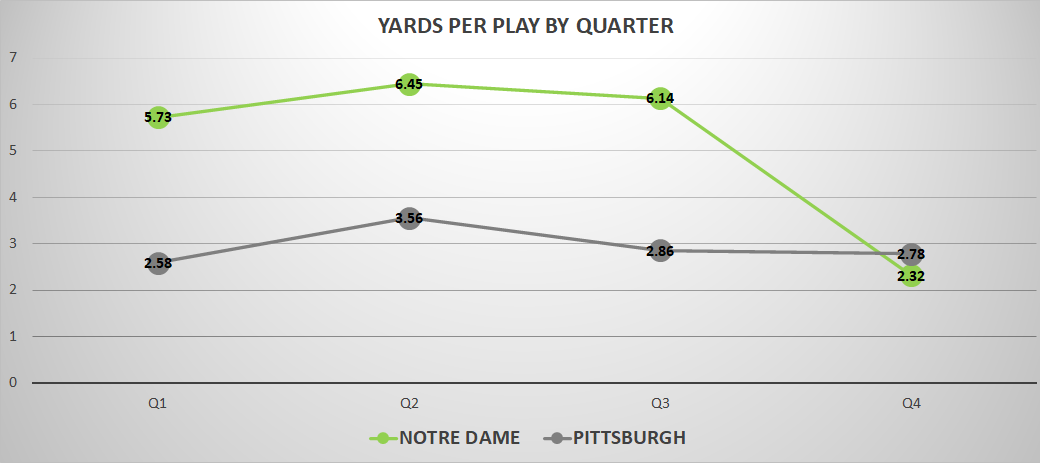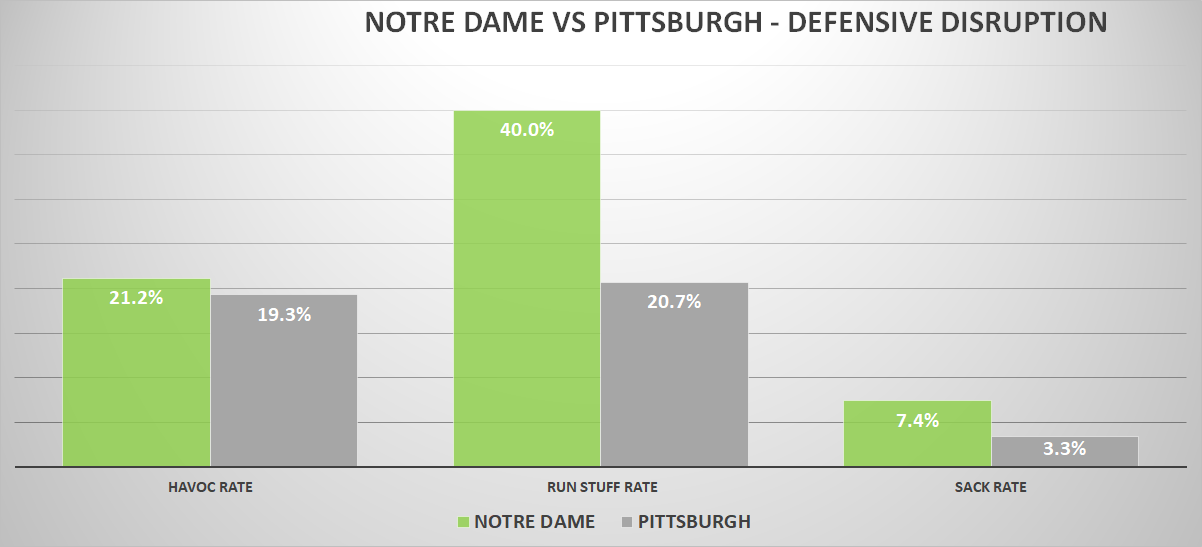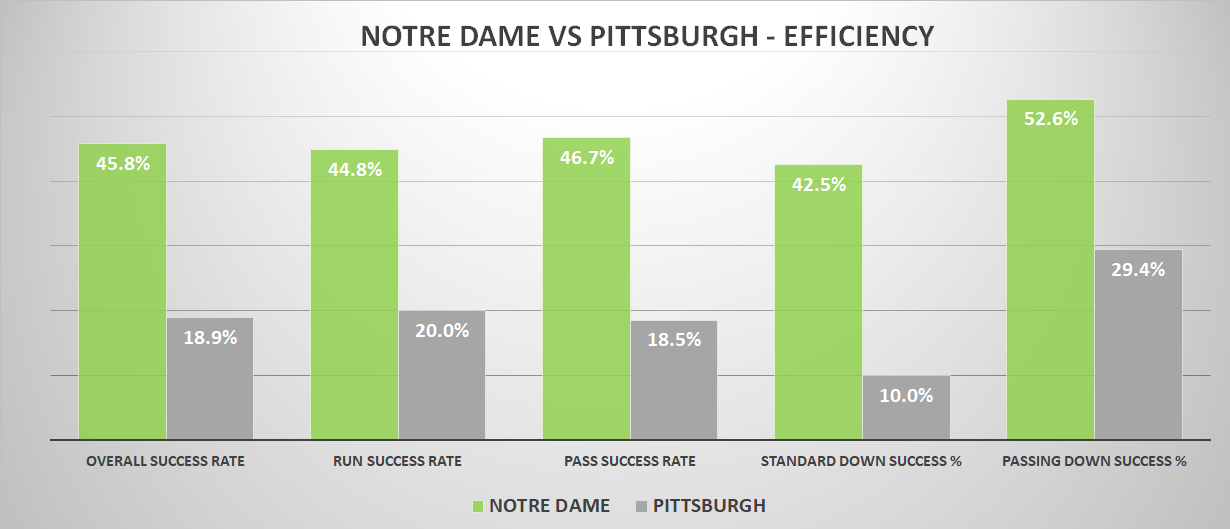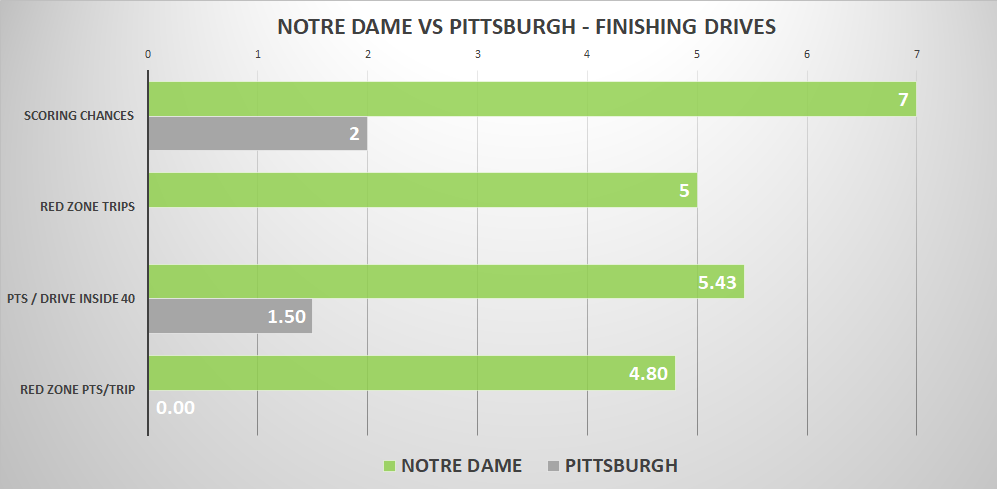Notre Dame dominated Pitt behind an explosive passing game, grinding out an efficient run game, and defensively abusing poor Joey Yellen and an abysmal Pitt rushing game. The Irish were due for some interceptions and came through with three, with a special teams touchdown added for good measure. A look at how Tommy Rees and Ian Book may distribute targets in the passing game with the loss of Kevin Austin (and in the near-term Braden Lenzy), and how both sides of the ball are setting up for 3rd down success.
Confused? Check out this handy advanced stats glossary here or reach out in the comments.
Garbage time started when Notre Dame scored to go up 38-3 with four minutes remaining in the 3rd quarter. That eliminates 28.9% of plays as garbage time, during which the Irish offense dipped from 6.2 yards per play to 2.8.

Explosiveness
A week of fretting about long passes reached a crescendo before gametime with the announcement Kevin Austin re-injured his foot and would be out for the season. Then Ian Book went out and completed four 20+ yard passes against the best defense he’s faced all season, including 107 yards worth of touchdowns to Bennett Skowronek. Book averaged a sterling 9.53 yards per attempt while the rushing game mustered only 2.76 yards per run (more on that later).
There was a lot to appreciate about the performance – from the downfield shots to decision-making in the pocket in the face of a strong and aggressive Pitt pass rush. And still there was some room for improvement – there were a few errant short throws Book would love to have back that weren’t on target. It feels like a performance PFF and film will like a little less than the numbers do, but that’s ok – it usually balances out with games like FSU, where the numbers were good but not great but the tape showed some excellent work.

Five games in, it’s fascinating to see how evenly Book has spread out his passing targets. Last year Chase Claypool (112), Cole Kmet (62), and Chris Finke (59) dominated the targets, with no other receiver gaining over 25. This season the combination of injuries and young players stepping up had resulted in a much more even distribution, with some breakouts and disappointments both in the mix.
Mayer starred against Pitt and is now leading the team in receptions, and I’m not sure the freshman can be targeted enough. The volume has slowly ramped up, but his per-play numbers compare similarly with Kmet’s last season – slightly lower yards per target, but better yards per catch and efficiency. With Tommy Tremble playing but not 100%, Mayer is only going to see more and more snaps moving forward.
The other standpoint, aside from Skowronek’s monster numbers in a small sample, is Kyren Williams. A lot of this production is from the long screen pass against Duke, but it’s notable given how little the Irish gained from running backs in the passing game in 2019. With Austin out, continuing to involve Williams and Chris Tyree and their versatility heavily in the passing game seems like an option.
One of the few negatives on Saturday was Lenzy reaggravating a hamstring injury late in garbage time. Why he was out there after being on a limited snap count in many of 2020’s contests I can’t answer. But the numbers show that even when playing the Irish hadn’t quite figured out how to get one of their most explosive players going.
The bottom line here is that if the passing offense has the support of a strong ground game, more performances from Good Ian, and a portfolio of receiving options, it may be able to withstand the absence of it’s two most talented receivers. The ceiling may have been lowered, but the floor is still solid and there’s been solid production per play despite the low volume of passes.

The Notre Dame defense continues to be extremely disruptive and take advantage of favorable matchups against overmatched offensive lines. Greg Flammang of UHND had a great point – the Irish defense has been so good limiting efficiency that they haven’t played many snaps, limiting the individual production of the defenders. The Panthers had only 10 runs before garbage time, with four of them stuffed for no gain or negative yardage. The sack numbers haven’t jumped out yet, although the Irish did get two more in garbage time to boost their totals.
Efficiency

The Irish continue to hold a massive efficiency edge on their opponents, holding them to well below average success rates while performing well offensively. The pass success rate is really high for a game where Book was 16-of-30 – there was only one completed pass that wasn’t a successful play (a 1-yard reception by Tremble), which speaks to the more aggressive attacks downfield. The Pitt secondary has been solid but a little leaky, so to be both efficient and explosive through the air is a harbinger of good things.
The running performance was extremely methodical, to say the least. The Irish were unable to break a long gain on the ground – the longest non-scramble before garbage time was an 8-yard run by Williams. But the ground game was terrific situationally, converting four 3rd and 1 rush attempts and with another strong game scrambling by Book. Excluding sacks, Book is now leading all Irish rushers in success rate (57.6%) and is tied with Chris Tyree in yards per rush (6.2, trailing only C’bo Flemister’s 6.6 YPC average).
A huge part of @NDFootball being 5-0 in the 2020 #CollegeFootball season is 3rd down. #NotreDame is converting 52% on 3rd down offensively and allowing opponent’s to convert just 21%. This 31 point differential is the highest among teams that have played multiple games this year.
— SportSource Analytics (@SportSourceA) October 26, 2020
As you can see above, Notre Dame is excelling on 3rd down, which is fueling a massive success rate edge. Is it sustainable? Some regression may be expected with better opponents still to come, but there’s strong underlying data. For the season, the average ND distance is 6.4 yards to gain versus 9.2 for opponents.
Pitt having more success on passing downs than standard downs is a new one, and likely more randomness with struggles in both areas than anything significant. The Panthers also faced nearly as many passing downs (17) as standard (20), thanks to averaging 0.92 yards per play on 1st downs.
Finishing Drives, Field Position, & Turnovers

A week after struggles in the red zone, this was an improved performance by the Irish offense. It wasn’t always pretty or easy, requiring a DPI call on McKinley and jump ball win by Mayer for two of the scores. But most importantly Notre Dame settled for just one field goal attempt and came up empty only on the final drive of the game as time expired. For the record that’s the third time that’s happened this year, so there’s some deflating of Brian Kelly’s season-long red zone numbers as a result.
The Irish were an extremely healthy +7 yards per possession better in the field position battle, thanks in large part to their three interceptions. Pitt’s last eight drives all started at or inside their own 25, which was a recipe for failure with Yellen and their struggles to even gain first downs.

Last week I wrote that the Irish were due for some improved interception luck given how many pass break-ups that had with so few interceptions, and it quickly came to fruition. Notre Dame played a clean game, with the only fumble an Avery Davis loss as he was going out of bounds that had no real chance of a Panther recovering it. Two of Pitt’s fumbles came in garbage time (in addition to the muffed punt), so those were less impactful than the box score might suggest.




In the past 2 games, the ND defense has allowed 1 trip inside the red zone. That’s pretty good.
I’m not sure if you have the answer to this, but I noticed that ND (for lack of a better word) “pads” some of their stats against lesser opponents. For example, the 3 interceptions this one week compared to very few in the other games. Also, it seemed like last year ND went off on one of their opponents with a bunch of sacks in one particular game. Is this normal for most top tier programs? Does a team like Clemson tend to have low interception and sack totals game to game, but then a lot against a very poor team?
I don’t think ND is doing anything unique in terms of some of those plays coming in bunches and especially against bad teams. Especially with things like sacks and interceptions things can pretty easily snowball – Bad Team gets behind, needs to throw, and has disadvantages on the DL and not great QB + WRs so it’s a bad recipe. Long story short, turnovers are fairly random so having a few outliers isn’t surprising, and sacks can often be a matchup or QB determined thing.
Offensively I actually think ND is more conservative than some other power programs – we hardly ever seem to let our second-stringers throw in garbage time and when we do it’s often a very conservative run-run-pass.
As an aside, it still fascinates me to see how playing a conference schedule has weakened our strength of schedule. Without Covid, we’d have played Wisconsin by now, and I think we would have played Stanford, and would still have Clemson and USC coming up.
If there is ever an evidentiary basis for staying independent in football, this is the season for that.
ND would have already played Navy, Arkansas, Wisconsin and Stanford (and also played Wake and Pitt plus Western Michigan). Especially with Arkansas looking stronger than expected with their new coach I think all of those games, other than Western Michigan and the normal ACC games would have been more intriguing than what has happened so far.
It’s kinda a weird holding pattern the last 3 years where Notre Dame never loses to unranked teams but then can’t stack up when they play top 5 teams. Would have been nice to have some competitive but still winnable games (USC, Wisconsin, Arkansas) in the mix to at least see them beating some strong teams.
Hopefully UNC keeps winning so the Irish can at least get one T25 win.
Kinda feels like ND is going to be 10-1 and no one will think any different of them, whereas going 10-1 with their original 2020 schedule would have been a pretty impressive accomplishment.
It definitely shows that playing in a conference isn’t a magical solve for strength of schedule. Deep down I think everyone knows that but no one really argues ND needs to join a conference in good faith (I at least respect people who would transparently admit it’s just they don’t like it or are jealous).
Divisions make a big difference too, you’ve had Wisconsin and Iowa teams go undefeated late in the year and obviously be not playoff / BCS caliber, and conference membership didn’t necessarily mean anything for their SOS other than getting smacked in the B1G championship.
This season also exposes the potential downside of a conference for your playoff hopes – the conference championship can be upside, downside, or really nothing if you are beating a Pitt or Northwestern. If we lose a close one to Clemson at home we might be in better shape for playoff in the clubhouse at 10-1 vs another matchup where a loss guarantees we are out.
I agree, hooks, that ND has consistently been beating the teams they should beat but lay an egg against the top competition. Some games against some top 10 teams like Wisconsin would be a good way to see where ND is relative to them
We’re a pretty odd duck in CFB in that respect — since 2017, we never get upset, and we never pull an upset.
Wait, which opponents are the lesser ones? Frankly, it’s difficult to tell anymore.